Canmore
Tochieneal Tileworks, mid 19th century. The decaying ruins of a small tileworks. There is a rectangular brick kiln of normal tile-works type, with lean-to covers for fire-holes.
The remains of ancillary buildings and a square-section brick chimney also survive. A light railway carried the clay down to the mill from the pit c100m to the west.
The works are depicted on the OS maps of 1846 and 1888.
‘Imported’ firebricks such as Glenyards, Preston Grange, Gartcosh and Forth have all been found on site.
Below – 17/04/1849 – Banffshire Journal – The clay bank of Smithstone – It has been said that the man who causes two stalks of corn to grow where only one grew before is the benefactor of his race, and the truth of this saving so obvious, that is altogether beyond the reach of contradiction. What then shall be said of the man who, foresight and the judicious investment of a little spare capital, has not only caused two stalks corn to grow where only one grew before but has been the instrument of making the stagnant marsh, the spongy and unprofitable morass, and the stiffest and most sterile soils, become fertile fields, yielding their liberal increase, and amply repaying the toil of the husbandman besides supplying great desideratum in the welfare and social improvement of society cheap food and abundant employment. We formed our first intimate acquaintance with the subject of our present sketch—the clay bank of Smithstone —in 1826. It was then our fortune to have to toil over with the sweat on our brow, in assisting to reap a very stunted and scanty harvest, beneath a broiling sun, with the temperature above degrees Fahrenheit. The season was certainly not one favourable for still clay soils, and our opinion the bank, and indeed the opinion of everyone capable of forming an opinion who knew it then, was, that farm of three hundred acres of it for nothing, would ruin anyone but a man of fortune. In 1832, we again assisted reaping the crop of the bank of Smithstone. which it may here be proper to remark, forms part of the farm of Tochieneal, the neighbourhood of Cullen, and is now, was then, possessed by John Wilson, Esq. The season of 1832 was more favourable than that of 1826 but still, the yield from the bank was far from good and we should think barely remunerative. While the steep and inaccessible nature of the ground rendered the expense of farming it proportionably great, our opinion of the bank was still the same. A few weeks since we had occasion to visit the scene of our former labours, and what a change! Instead of a stunted and unremunerative crop of grain, grass, or turnips, we found the little haugh at the foot of the bank covered to a great extent, with buildings of every shape and description, while from thirty to forty men and boys were busily engaged in the manufacture of bricks, house and drain tiles, chimney cans, flower pots, and a great variety of other articles, from the still and hitherto altogether unprofitable clay of the bank. We could not help standing, and gazing for some time with unfeigned satisfaction at the busy and animating scene around us. Here were a great number of individuals constantly and profitably employed, where scarcely one found employment before. But it would be taking a narrow view of the matter, indeed, to suppose for a moment that the comparatively few hands employed at the Brickfield (as it is called) are all who derive immediate benefit from its erection. They no doubt find employment, and obtain a liberal remuneration for their labour, and are thereby enabled to keep themselves and those dependent on them in comparative comfort, but the benefits directly or indirectly derived by them are perfectly insignificant compared with those conferred by the establishment on the public at large. We are not possessed of any data, or cognisant of the facts of the case, but can easily conceive that forty men and boys will, in the course of one week, make more drain tiles alone than twice forty ditchers will put in the ground in a month. But it is not merely as affording employment to a number of individuals, that undertakings such as the Tochieneal Brickwork are an advantage to the whole community. Our farmers are second to none in point of enterprise, nor is there to be found a locality where farming is carried on with more spirit or at greater expense than the lower districts of Banffshire; and as a proof of this, have only look at our immense exports of corn, cattle, and other produce, and the enormous sums paid for the manure which annually finds its way to our shores. But among all the improvements which of late years have been made in the science of agriculture certainly, none has been attended with more beneficial results than that of furrow or tile draining. It is not enough that our fields are fertilized with manure from the eastern shores of the Pacific, from the rock-bound coast of the desolate and inhospitable Patagonia and the shrubless isles, where the penguin and other seafowl bask themselves beneath the vertical blaze of the equinoctial sun. The benefits to be derived from the use of guano, bone-dust, and other expensive manures may be great, but they cannot be permanent without a complete and thorough system of drainage. Manure may do much, but it will not dry the sour and noxious swamp, nor break or pulverize the stiff and stubborn clay, and without proper drainage, it is continually liable to be run off with the surface water. Let us have drainage first and manure afterwards, and then we may indeed sow in hope that we will have two stalks of corn to reap where only one was want to be reaped before. Nor would it be at all difficult to point to hundreds of fields which, previous to the erection of the “Brickfield,” barely yielded sufficient to repay the expense of seed and labour, now yielding a large and profitable return, and are thus not only a source of profit to the landlord and farmer but are the means of making food cheap without any proportionate sacrifice on the part of the grower. We have, in the case of the Brickfield, a fine illustration of the benefits which one enterprising individual can confer on society; for although it is not assumed that this was the first or only brickwork established in the country, there can be no doubt that the great facilities which it afforded the farmers, enabling them to procure a cheap and convenient supply of tiles, coupled with the spirited example shown by Messrs Wilson themselves, gave, the time of its erection, strong and effective impulse to the spirit for improvement; and our object in writing the present notice, is not simply to supply a well-merited need of praise to the gentleman who was the originator of it—for that would be almost a work of supererogation but for the purpose of stimulating others who are possessed of the sinews of enterprise—a little spare capital—to go and do likewise. It is not, however, the investment of capital under the impulse of a reckless spirit of speculation that will or can become a public benefit. To be so, the investment must be a judicious and advantageous one, otherwise, ruin, instead of lasting and permanent good, must inevitably be the result. Although it would be, and is, difficult to conceive how the hands employed by the transformation of the clay bank of Smithstone into drain tiles could be otherwise employed so to afford an equal amount of remuneration to their employer and benefit to the public. There can be no doubt that there are yet many hidden and unexplored sources of wealth around, as heedlessly passed over now as the clay bank was of old, but which, in the course of a few short years may, like it, affording ample employment and remuneration to more than twice their number. Neither Cumnock, Laurencekirk, or Auchinleck, so far as are aware, are possessed of any peculiar local advantages for the manufacture of snuff-boxes, yet it is well known that all these places, the making of snuff-boxes alone employs constantly a great number of hands, the product whose labour amounts to several thousand annually; while many towns and villages possessed of equal facilities, not one penny is realised for the manufacture of the same sort goods. It is stated by Professor Jamieson, that at Zoblitz in Germany, upwards of three hundred families find employment cutting the marble of the district into trinkets, and carrying them all over the country for sale, but (adds the same writer) the Portsoy marbles are much finer than those of Zoblitz and susceptible of a higher polish. How strangely does this contrast with the fact that the much finer Portsoy marbles scarcely afford employment for one individual? We do not make these observations for the purpose of inducing our readers to become Lapidarians or snuff-box manufacturers, but for the sake of illustration, and for the purpose of showing those who are possessed of a little capital, that there are yet many things besides the clay bank of Smithstone wherein they might invest their money with profit to themselves and vast advantage to the public at the same time; and let those who are possessed of the requisite means only reflect that all that is necessary to open up these hitherto scaled sources of wealth is a little money, spirit of enterprise, and the exercise of sound judgment. It is well known that the whole of Banffshire has for a long time, been altogether destitute of manufactures of any description, and it would be difficult to assign any reason for its being so, except that the inhabitants are not actuated by a proper spirit of enterprise, for there is no lack of the requisite capital.
Below – 05/09/1851 – Elgin Courant – Fatal accident of a 6-year-old boy, the son of the manager John Thom.

08/12/1852 – Aberdeen Press and Journal – The representatives of the late Mr Wilson, Tochieneal beg to intimate that they continue to carry on in all its branches the manufacture of bricks, tiles and other pottery ware as carried on by the late Mr Wilson. The stock currently on hand is both select and extensive, comprehending all descriptions of drain tiles, roofing tiles, water pipes, building bricks, chimney cans and general pottery ware. Orders may be addressed to Alexander Wilson, Tochieneal by Cullen. 01/12/1852.
Below – 28/03/1856 – Elgin Courant – Accident at Tochineal Brick and Tile Works.

Below – 11/07/1856 – Elgin Courant – Accident at Tochineal Brick and Tile Works.

1857 – Tochieneal Brick and Tile Works. Hugh Wilson Manager, Cullen.
Below – 1866 – Tochieneal Tile Works, Cullen.
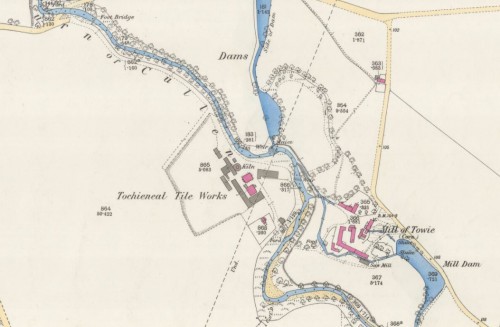
01/11/1866 – Northern Ensign – To proprietors, farmers &c. The Tochieneal Tileworks near Cullen continues to supply drain pipes, tiles &c. Prices will bear comparison with those of any other company and will be learned with other particulars on applying to John Merson, accountant, Union Bank of Scotland, Wick. Agent for the Wich District. Tochieneal. Sept. 1866.
1867 – Mrs Wilson, brick and tile maker, Tochieneal, Cullen. (Page 465).
1867 – 1869 – ScotlandsPlaces – An extensive tile works on the Seafield Estate.
Below – 28/02/1867 – John O’Groat Journal – David Leith, Wick, stocking Tochineal tiles, bricks and chimney cans.

18/08/1870 – Inverness Courier – Seafield Estate – Cullen District. The following farms belonging to the Earl of Seafield will be let on 19-year leases … Tochieneal with distillery and tile works presently occupied by the representatives of the late Mr John Wilson … the well known Tochieneal distillery is presently occupied in connection with the farm as also a brick and tile work. These can be held advantageously with the farm and will be let along with it. An extensive trade has been carried on for many years at both establishments and to a person of enterprise and capital, the whole would prove to be a good investment.
29/12/1877 – The Scotsman – Tochieneal Farm for let presently occupied by the representatives of the late Charles D Forbes Esq and includes a profitable brick and tile work upon the farm which is held in a lease for the same period as the land …
27/02/1879 – Aberdeen Press and Journal – Tochieneal Farm, the property of the Earl of Seafield to let … there is also a brick and tile work upon the farm at which an extensive and profitable trade has been carried on for many years … 13/12/1878 Cullen House.
Below – 18/01/1881 – Banffshire Journal – Advert for Tochieneal Tileworks selling drain pipes, mugs, house tiles, bricks and flower pots etc.

18/07/1882 – Banffshire Journal – Article on Tochieneal – In the stables at Tochieneal are five pairs of powerful horses of Clydesdale character as are to found on few farms in the north of Scotland. Five pairs would, of course, in ordinary circumstances be too great a strength for the extent of the land under rotation, but here there is an exceptionally great amount of cartage. The large force gives an opportunity for taking advantage of a short period of suitable weather for any particular operation, which is an important matter, considering the character of the land. The work can be done off at a spurt while the land is in fit order. Then the horses are turned to work in connection with the brickwork on the farm, which we allude to below or in carrying manure … and

.

29/12/1886 – Aberdeen Free Press – The Countess Dowager of Seafield has very considerately given employment to the labourers at the Tochieneal Brickwork, who are necessarily out of work at this season, by engaging them to make drains on the farm of Woodside.
02/06/1893 – Elgin Courant – James Murdoch, carter, Ellieside, was charged with having, on 27th April last, on the road between Ellieside and Tochieneal Brickworks, attacked and assaulted William McBean, cutler, Fordyce, by seizing hold of him by the jacket, dragging him to the ground, and striking him several blows on the head, arms, and legs, with the butt-end of a whip, and kicking him. He was also charged with having, in a brick kiln at Tochieneal Brickworks, attacked and assaulted McBean, and struck him several blows on the head with a piece of coal to the effusion of blood. Murdoch pleaded not guilty and, under examination, McBean deponed that on the 27th he was attacked and maltreated without any provocation by the accused, who was leading two carts on the road. He followed the accused and struck him. George Mitchell, employed in the tileworks, was next called, and he deponed that he saw the cutler attacking Murdoch, and strike him on the head with a stone. He did not see any blood on McBean’s head. While the cart was being emptied he put the cutler into a kiln to stop the fight. He saw blood on McBean’s head after he came out of the kiln. In answer to Mr Anderson, the accused said that McBean had threatened him for the last six months, but he had never paid any attention to him. The case was dismissed on the ground of insufficient evidence.
Below – 1902 – Tochieneal Tileworks.
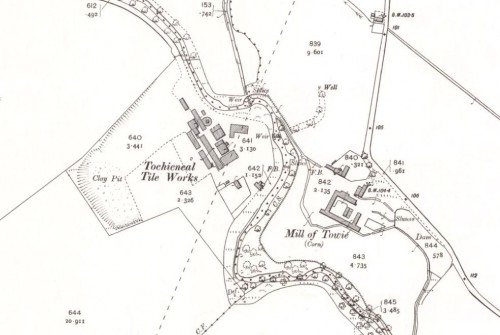
Below – 20/05/1902 – Banffshire Journal – The end of a long tenancy Rettie Farm, Boyndie. For 152 years the Longmores have been interested parties in the farm and much is indeed owned by the late Mr Andrew Longmore father of the outgoing tenant Mr George Longmore … Mr Longmore was the earliest to introduce drain tiles into the district. He first used them in 1831. Previously he had been accustomed to using stones in the formation of drains but some difficulty arising about the supply of stones, and on making application to Mr Fraser, the commissioner, to Lord Seafield, on the subject, that gentleman suggested that Mr Longmore might try drain tiles, Mr Fraser adding that he saw they were making drain tiles somewhere about Portobello. Mr Longmore acted on the hint and brought down the tiles. They were brought down on the sloop Jean, belonging to Captain Milne, Macduff and a good number of them were laid down on the roadside. It is remembered that people passing to the church on Sunday looked at them and wondered if they were some new fangled manure that Rettie had got. A short time after the drain tiles were laid, Mr Longmore happened to be at Tochieneal and the late John Wilson asked him whether, if he got the stones easily, he would not prefer to use them instead of the drain tiles. Mr Longmore said that undoubtedly he would use the drain tiles in preference to the stones even though they cost him more. On receiving the answer, Mr Wilson set about the erection of the tile work at Tochieneal which has since been retained with so much advantage to the district …
1903 – Tochieneal Brick & Tile Works, James Moir Sec, Cullen.
12/08/1903 – Aberdeen Press and Journal. Marriage. At the Brickfield, Tochieneal on 7th inst, by the Rev G.G. McLean, Cullen, Andrew Cairns Crockett, burgh surveyor, Inverurie to Jeannie Greenlaw, niece of James Burnett, manager Brickfield Tochieneal.
14/09/1939 – Aberdeen Weekly Journal … Marriage of William Niven and Margaret Dalgarno, daughter of the late William Dalgarno, Tileworks, Tochieneal …
1942 – 1943 – Tochieneal Brick & Tile Works, Tochieneal
**************************************
The following clay products have been found on-site and are believed to have been made at Tochnieneal.
Below – ‘D’ shaped, flat bottomed drainage tile – outside diam 100 mm. The length is unknown as it is broken.

.

Below – Oversized brick – 70 mm x 105 mm x 310 mm.

.

Below – Cored brick – 75 mm x 110 mm 230 mm – 10 holes.

Below – Cored brick – 67 mm x 110 mm 230 mm – 2 x D shaped and 2 oval holes – roughly 26 mm x 53 mm each.

Below – Brick – 70 mm x 110 mm x 230 mm.

Below – Drainage brick ? – 70mm x 110mm x 230mm – 2 oval holes 30mm x 40mm each.

.

Below – The same brick as above. This was kindly donated by Peter Mason. It shows a curl of clay at one end that appears to have collected as a lifting tool (with an apparent sharp edge) has been shoved into one of the holes. As it was pushed in it has curled a slither of clay in front of it which has caught at the end. That same hole at the other end also shows evidence of having been slightly enlarged by the tool as it was pushed in or pulled out.

.

.

Below – 2 x horseshoe large drainage tiles – the largest is big enough to be a possible Hogsback Roof ridge tile?
Smallest 150 mm high x 185 mm wide at bottom x 360 mm long.
Largest 180 mm high x 265 mm wide at bottom x 36o mm long.

.

Note that each tile has the same 4 pockmarks to the flat of the underside – top left of each tile on the photo below.

Below – Ridge tile – 140 mm high – 240 mm widest and 410mm long.

.

Below – S-shaped roof tile 255 mm x 386 mm

Below – 3 stamped horseshoe drains found by Ian Suddaby on site
No 1, No 2, No 5
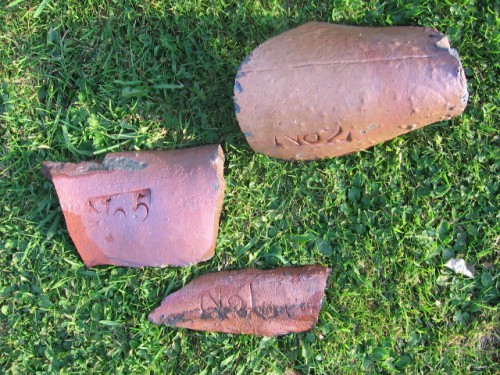
Below – Ridge tiles
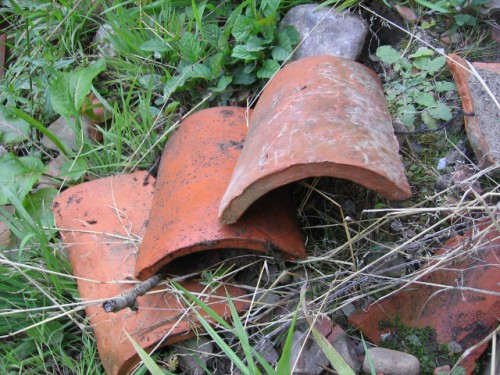
The following are examples of blown and misfired products found on site
Below – 100mm diam field drain

.

Below – Photographs by Ian Suddaby.
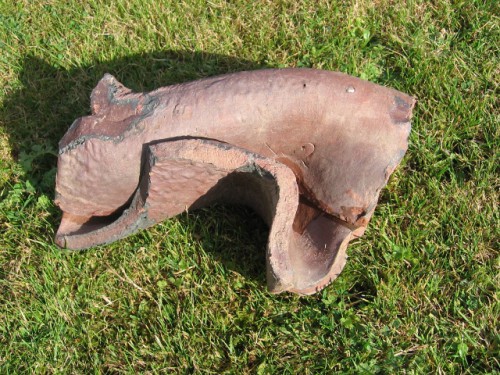
.
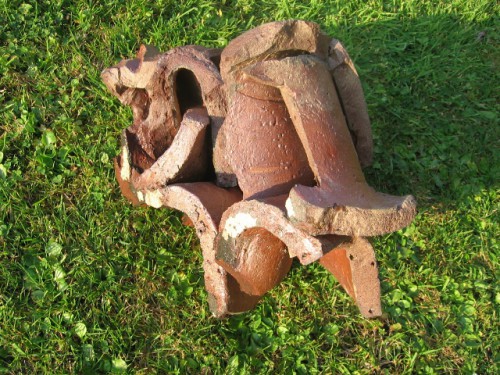
Below are some photos of the site taken in 2015.
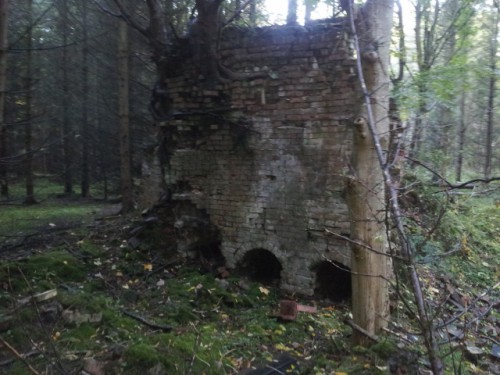
.
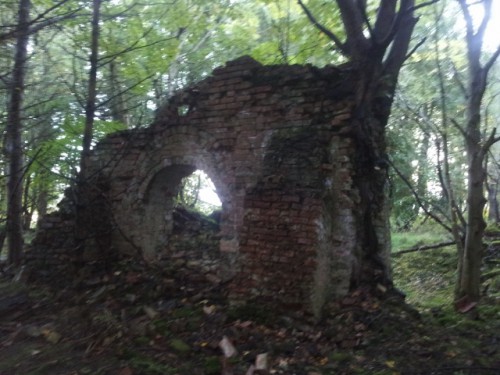
.
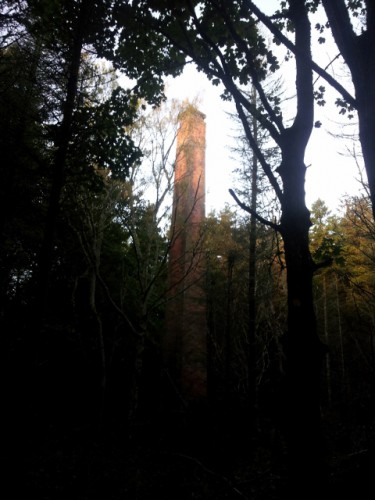
Below – Waster horseshoe drainage tiles stamped to one end with various sets of initials. These initials are very likely to belong to the individual moulders who formed the tiles/pipes. Many thanks to Ian Suddaby for collecting these and donating them to the cause. DB, JS, JT and AB

.

.

.

.

.

Below – Kindly donated by Peter Mason. This is an elongated example of a ‘drainage brick’ or a hollow internal building brick with 2 elliptical voids running the length of the brick. It measures 12″ long.

.













































